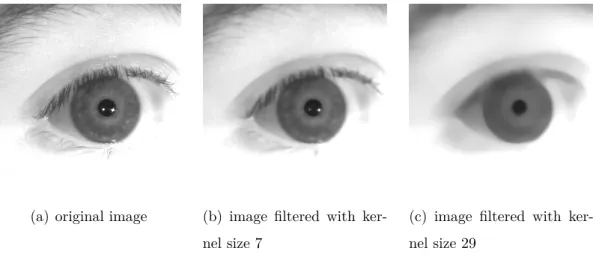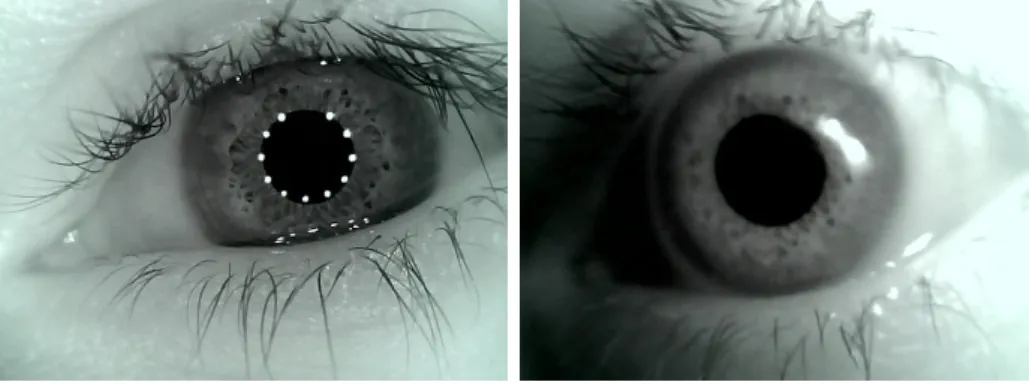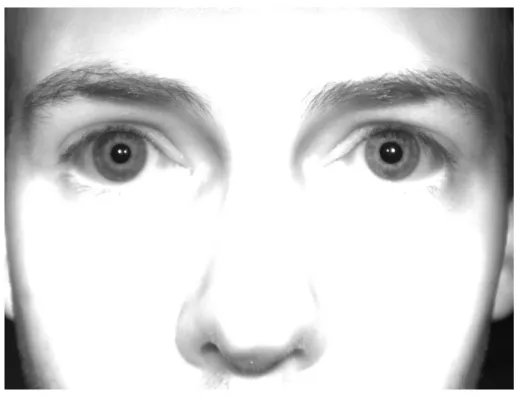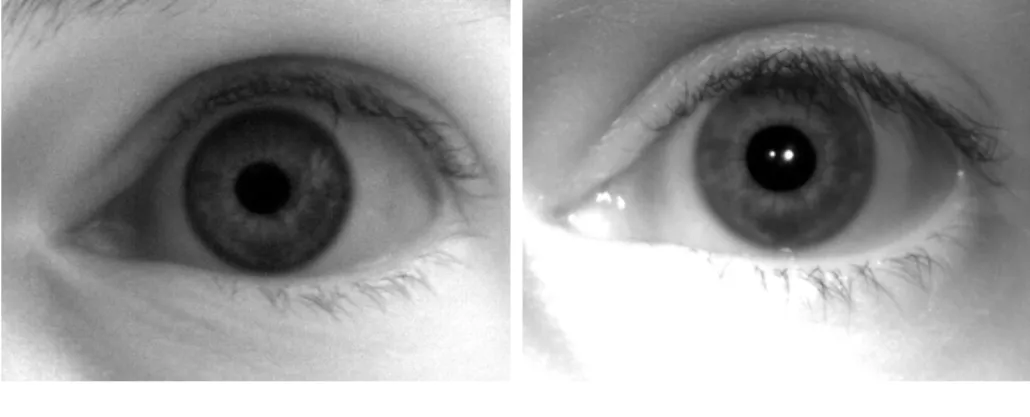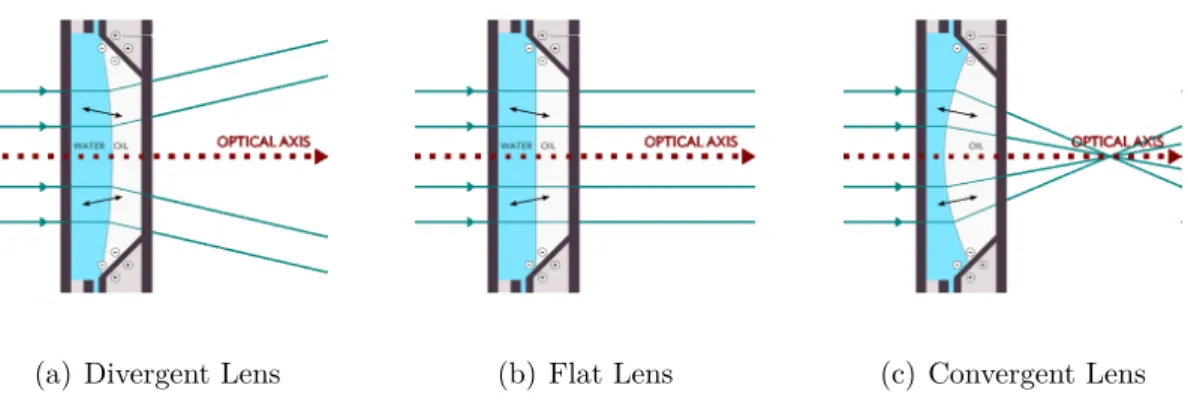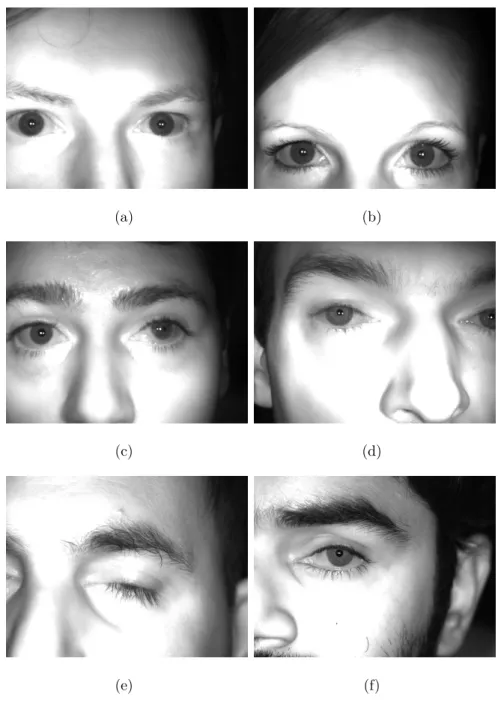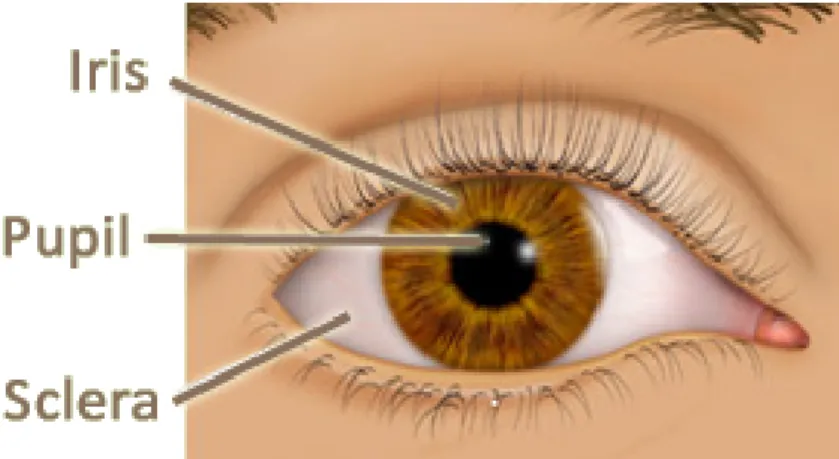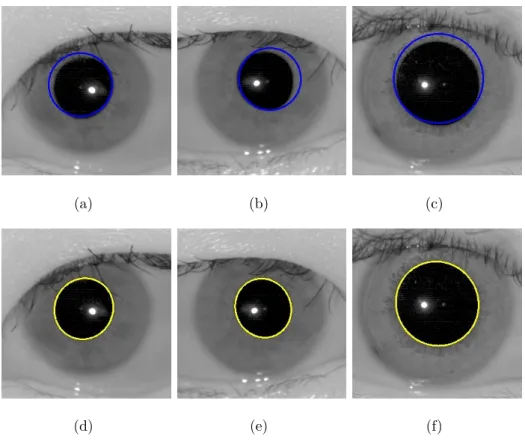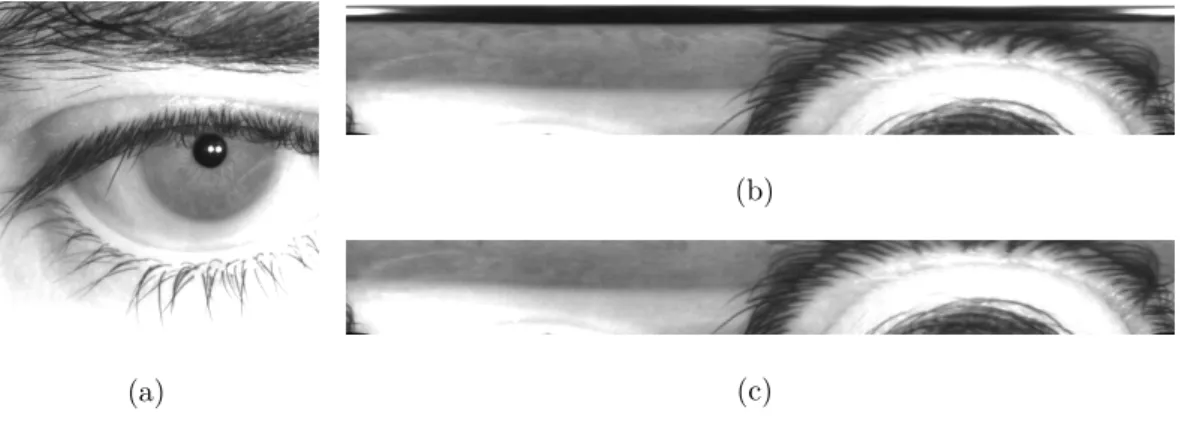Machine Learning Techniques and Optical Systems for
Iris Recognition
from Distant Viewpoints
Dissertation
zur Erlangung des Doktorgrades der Naturwissenschaften (Dr. rer. nat.)
der Fakultät Physik der Universität Regensburg
vorgelegt von Florian S. Langgartner
aus Regensburg
im Jahr 2019
Die vorliegende Dissertation entstand während einer dreijährigen Zusammenar- beit mit der Firma Continental Automotive GmbH, ansässig in der Siemens- straße 12 in 93055 Regensburg.
Das Promotionsgesuch wurde am 14.05.2019 eingereicht.
Die Arbeit wurde von Prof. Dr. Elmar Lang angeleitet.
Prüfungsausschuss:
Vorsitzender: Prof. Dr. Josef Zweck 1. Gutachter: Prof. Dr. Elmar Lang 2. Gutachter: Dr. Stefan Solbrig
weiterer Prüfer: PD Dr. Alfred Weymouth
Contents
1 Introduction 1
2 Techniques 5
2.1 Histogram Equalization . . . . 6
2.2 CLAHE . . . . 7
2.3 Z-Score Transform . . . . 7
2.4 Sharpening Filters . . . . 8
2.5 Median Filtering . . . . 10
2.6 Hough Transform . . . . 11
2.6.1 Canny Edge Detection . . . . 11
2.6.2 Hough Line Transform . . . . 12
2.6.3 Hough Circle Transform . . . . 13
3 Optical Systems 15 3.1 Foscam IR Night Vision Camera . . . . 16
3.1.1 Camera . . . . 16
3.1.2 Pictures . . . . 17
3.2 Basler Automotive Camera . . . . 19
3.2.1 Camera, Sensor, Objective Lens and NIR LEDs . . . . . 19
3.2.2 Pictures . . . . 22
3.3 Auto Focus . . . . 24
4 Database 29
5 Iris Recognition 33
5.1 Preprocessing . . . . 36
5.1.1 Sharpness Check . . . . 36
5.1.2 Brightness Invariance . . . . 39
5.1.3 Eye Gaze Removal . . . . 41
5.2 Segmentation . . . . 43
5.2.1 Hough Circle Transform . . . . 44
5.2.2 Snake Algorithm . . . . 46
5.2.3 Segmentation in the Polar Representation . . . . 51
5.2.4 Unet Segmentation . . . . 53
5.2.5 Performance . . . . 56
5.3 Noise Removal . . . . 59
5.3.1 Hough Transform . . . . 60
5.3.2 Variance Based Removal . . . . 61
5.3.3 Canny Based Removal . . . . 62
5.3.4 Adaptive Thresholding . . . . 63
5.3.5 Performance . . . . 65
5.4 Segmentation Quality Check . . . . 68
5.4.1 Shape Count Check . . . . 69
5.4.2 Histogram Based Check . . . . 70
5.4.3 Performance . . . . 72
5.5 Normalization . . . . 74
5.6 Feature Extraction . . . . 78
5.6.1 1D Log-Gabor Filter . . . . 79
5.6.2 2D-Gabor Filter . . . . 79
5.6.3 Phase Quantization . . . . 80
5.6.4 Performance . . . . 82
5.7 Matching . . . . 83
5.7.1 Hamming Distance . . . . 83
5.7.2 Rotational Invariance . . . . 84
5.7.3 Score Normalization . . . . 86
5.7.4 Template Weighting . . . . 87
vi
5.7.5 Performance . . . . 89
6 Periocular Recognition 93 6.1 Feature Extraction . . . . 94
6.1.1 Local Binary Pattern Histogram (LBPH) . . . . 95
6.1.2 Z-Images . . . . 97
6.1.3 Deep Neural Networks . . . . 99
6.1.3.1 Deep Belief Network . . . . 99
6.1.3.2 Residual Neural Network . . . 101
6.2 Classifiers . . . 103
6.2.1 Cosine Distance . . . 103
6.2.2 Jensen-Shannon Divergence . . . 104
6.3 Performance . . . 105 7 Liveness Detection and Anti-Spoofing 109
8 Performance 115
9 Conclusion and Prospects 123
A Images recorded with the FOSCAM Night Vision Camera 127
B Images recorded with the Basler Automotive Camera 129
C Images from the Self-Recorded Database 133
Abstract
Vorhergehende Studien konnten zeigen, dass es im Prinzip möglich ist die Meth- ode der Iriserkennung als biometrisches Merkmal zur Identifikation von Fahrern zu nutzen. Die vorliegende Arbeit basiert auf den Resultaten von [35], welche ebenfalls als Ausgangspunkt dienten und teilweise wiederverwendet wurden.
Das Ziel dieser Dissertation war es, die Iriserkennung in einem automotiven Umfeld zu etablieren. Das einzigartige Muster der Iris, welches sich im Laufe der Zeit nicht verändert, ist der Grund, warum die Methode der Iriserkennung eine der robustesten biometrischen Erkennungsmethoden darstellt.
Um eine Datenbasis für die Leistungsfähigkeit der entwickelten Lösung zu schaffen, wurde eine automotive Kamera benutzt, die mit passenden NIR-LEDs vervollständigt wurde, weil Iriserkennung am Besten im nahinfraroten Bereich (NIR) durchgeführt wird.
Da es nicht immer möglich ist, die aufgenommenen Bilder direkt weiter zu ve- rabeiten, werden zu Beginn einige Techniken zur Vorverarbeitung diskutiert.
Diese verfolgen sowohl das Ziel die Qualität der Bilder zu erhöhen, als auch
sicher zu stellen, dass lediglich Bilder mit einer akzeptablen Qualität verar-
beitet werden. Um die Iris zu segmentieren wurden drei verschiedene Algo-
rithmen implementiert. Dabei wurde auch eine neu entwickelte Methode zur
Segmentierung in der polaren Repräsentierung eingeführt. Zusätzlich können
die drei Techniken von einem "Snake Algorithmus", einer aktiven Kontur Meth-
ode, unterstützt werden. Für die Entfernung der Augenlider und Wimpern aus dem segmentierten Bereich werden vier Ansätze präsentiert. Um abzusichern, dass keine Segmentierungsfehler unerkannt bleiben, sind zwei Optionen eines Segmentierungsqualitätschecks angegeben. Nach der Normalisierung mittels
"Rubber Sheet Model" werden die Merkmale der Iris extrahiert. Zu diesem Zweck werden die Ergebnisse zweier Gabor Filter verglichen. Der Schlüssel zu erfolgreicher Iriserkennung ist ein Test der statistischen Unabhängigkeit.
Dabei dient die Hamming Distanz als Maß für die Unterschiedlichkeit zwischen der Phaseninformation zweier Muster. Die besten Resultate für die benutzte Datenbasis werden erreicht, indem die Bilder zunächst einer Schärfeprüfung unterzogen werden, bevor die Iris mittels der neu eingeführten Segmentierung in der polaren Repräsentierung lokalisiert wird und die Merkmale mit einem 2D-Gabor Filter extrahiert werden.
Die zweite biometrische Methode, die in dieser Arbeit betrachtet wird, benutzt die Merkmale im Bereich der die Iris umgibt (periokular) zur Identifikation.
Daher wurden mehrere Techniken für die Extraktion von Merkmalen und deren Klassifikation miteinander verglichen. Die Erkennungsleistung der Iriserken- nung und der periokularen Erkennung, sowie die Fusion der beiden Methoden werden mittels Quervergleichen der aufgenommenen Datenbank gemessen und übertreffen dabei deutlich die Ausgangswerte aus [35].
Da es immer nötig ist biometrische Systeme gegen Manipulation zu schützen, wird zum Abschluss eine Technik vorgestellt, die es erlaubt, Betrugsversuche mittels eines Ausdrucks zu erkennen.
Die Ergebnisse der vorliegenden Arbeit zeigen, dass es zukünftig möglich ist biometrische Merkmale anstelle von Autoschlüsseln einzusetzen. Auch wegen dieses großen Erfolges wurden die Ergebnisse bereits auf der Consumer Elec- tronics Show (CES) im Jahr 2018 in Las Vegas vorgestellt.
x
Abstract
Previous research has shown that it is principally possible to use iris recog- nition as a biometric technique for driver identification. This thesis is based upon the results of [35], which served as a starting point and was partly reused for this thesis. The goal of this dissertation is to make iris recognition avail- able in an Automotive Environment. Iris recognition is one of the most robust biometrics to identify a person, as the iris pattern is unique and does not alter its appearance during aging.
In order to create the database, which was used for the performance evalua- tions in this thesis, an Automotive Camera was utilized. As iris recognition is best executed in the near infrared (NIR) spectral range, due to the fact that even the darkest irises reveal a rich texture at these frequencies, the optical system is combined with suitable near infrared LEDs.
As the recorded images cannot always be processed right away, several prepro-
cessing techniques are discussed with the goal of enhancing the image quality
as well as processing only images that have an acceptable quality. In order
to segment the iris, three different algorithms were implemented. Thereby, a
newly developed Segmentation in the Polar Representation is introduced. In
addition, the three techniques can be enhanced by a Snake Algorithm, which is
an active contour approach. For removing the eyelids and eyelashes from the
segmented area, four noise removal approaches are presented. For the goal of
ensuring that no fatal segmentations slip through, two options for a segmen- tation quality check are given. After the normalization with the rubber sheet model, the feature extraction is responsible for collecting the iris information, therefore, the results using a 1D-Log Gabor Filter or a 2D-Gabor Filter are compared. In the end, the key to iris recognition is a test of statistical inde- pendence. For this reason, the Hamming Distance serves well as a measure of dissimilarity between the phase information of two patterns. The best results for the database in use are gained by checking the image with a Sharpness Check before segmenting the iris by utilizing the newly introduced Segmenta- tion in a Polar Representation and the 2D-Gabor Filter as feature extractor.
The second biometric technique that is considered in this thesis is periocular recognition. Thereby, the features in the area surrounding the iris are exploited for identification. Therefore, a variety of techniques for the feature extraction and the classification are compared to each other. The performances of iris recognition and periocular recognition as well as the fusion of the two biomet- rics are measured with cross comparisons of the recorded database and greatly exceed the initial values from [35].
Finally, it is always required to secure biometric systems against spoofing. In the course of this thesis a printout attack served as the scenario that should be prevented, wherefore a working countermeasure is presented.
The results of this thesis points to the possibility of utilizing biometrics as a personalized car key in the future. Due to this huge success, the findings were also presented at the Consumer Electronics Show (CES) in 2018 at Las Vegas, yielding a great amount of feedback.
xii
Chapter 1. Introduction
Chapter 1 Introduction
In the automotive industry four Megatrends can be identified. These are Safety, Environment, Affordable Cars and Information.
At first, the Safety Megatrend unites all those technologies that aim to increase the vehicle safety. The long term vision of automated driving, connected with the vision zero – zero fatalities, zero injuries, zero accidents – corresponds to this domain. It is currently most driven by Google and Tesla, the leaders con- cerning automated driving.
The Environment Megatrend tries to reach the goal of zero emissions, for exam- ple by using fewer fossil fuels. The carbon dioxide emissions shall be reduced in order to make the automotive world greener and cleaner, as well as less cli- mate harming. Recent developments especially in relation with, as well as due to, the exhaust gas scandal show intensified advances towards fully electrified vehicles and fuel cell engines.
The third Megatrend is to make the existing technologies available in Afford-
able Cars. Of course, prosperity gaps and diverse expectations on cars require
varying definitions for different parts of the world. In Western Europe and the
United States of America the price limit for affordable cars is about 10, 000 Eu-
Chapter 1. Introduction
ros, whereas people in other parts of the world could never afford this amount of money, nor would they label this as cheap.
Last but not least, the Information Megatrend deals with gathering and using more and more pieces of information. It aims at optimizing the selection of presented data in order to adequately inform the driver. Moreover, it is sup- posed to prevent overcharging the attention of the driver for allowing relaxed and secure driving.
This thesis aims to contribute to the progress in the Information Megatrend.
Since the possibility to robustly identify persons using biometric technology has been around for some years, the automotive industry wants to integrate these technologies in their environment, too. There are several possibilities to recognize individuals by biometric aspects, for example optically, thermally, capacitively or electrophorensicly. All of of them have different costs and se- curity levels.
Generally, the methods can be differentiated between static and dynamic. Dy- namic or behavioral biometric characteristics for example include gait analysis, voice analysis, signature analysis and keystroke dynamics. Common static or physiological biometric technology covers fingerprint recognition, face recogni- tion, DNA sequence analysis, retinal scans and many more.
One of the most secure methods with comparatively low costs and the benefit of a relatively low time consumption is iris recognition. It is ideal for an inte- gration in vehicles, as the required optical systems are already existing or will be available soon for modern cars.
This thesis is based upon the results of [35], which made the first steps towards iris recognition in an automotive environment from distant viewpoints, with realtime recognition and as little cooperation from the subjects as possible.
All this with the goal of enhancing theft protection by only allowing autho-
2
Chapter 1. Introduction
rized people to start the engine. Therefore, [35] served as a starting point and
was partially reused in this thesis. Similarly, the existing implementation using
Python and OpenCV [29] was reutilized as a base for the comprehensive ad-
vances that will be presented in the following chapters. On top of the presented
approaches, plenty other techniques were tried that will not be described, as
this would vastly increment the size of this thesis, though adding only little
additional information. The idea was to catch up with the open issues and
ideas of [35] and finally implement the system in a car demonstrator, always
keeping the long-term vision of completely replacing the car key by biometric
technology in mind, which requires excellent recognition rates.
Chapter 2. Techniques
Chapter 2 Techniques
The following chapter introduces some general computer vision and machine learning techniques that were used throughout this thesis. Histogram Equaliza- tion (see 2.1) is utilized to optimize the usage of the full range of allowed values in an image. Thereby, contrast is enhanced globally. Contrast Limited Adap- tive Histogram Equalization (CLAHE) (see 2.2) is an extension to Histogram Equalization. It enhances contrast not only globally but also locally. The Z- Score Transform (see 2.3) allows the standardization of distributions in a way that they become comparable to other distributions. In order to sharpen an image, two different Sharpening Filters (see 2.4) are presented, namely Lapla- cian Filters and a method named Unsharp Masking. Median Filtering (see 2.5) is a possibility to remove noise without smoothing the edges of an image.
Finally the Hough Transform (see 2.6) is a tool that can be used in order to
find simple geometric shapes, such as lines or circles. Thereby, usually a Canny
Edge Detector (see 2.6.1) is utilized, which is a commonly used technique for
edge detection, based on Sobel Filtering.
2.1 Histogram Equalization Chapter 2. Techniques
2.1 Histogram Equalization
Histogram Equalization [51, 62] is a technique for adjusting intensities in order to enhance the overall image contrast by stretching the intensity range. The distribution of a histogram is mapped to a more uniform and wide distribution of intensity values, making use of the maximum possible range. The first step for an 8 bit monochrome image with 256 possible intensities is to calculate the probability p(i), with which each intensity value occurs with. This is done by
p(i) = n
iN , (2.1)
with n
ias the number of pixels with intensity i ∈ [0, i
max], i
max= 255, and N the total number of pixels N . The cumulative distribution function F
cdis given by
F
cd(i) =
i
X
j=0
p(j) . (2.2)
It has to be multiplied with the size of the intensity range i
max, in order to obtain the complete transformation function T (i) [35]
T (i) = i
maxi
X
j=0
